Clinical Audit Proposal: Pressure Ulcer Prevention in ICU Setting
VerifiedAdded on 2019/10/30
|12
|3146
|1225
Report
AI Summary
This audit proposal outlines a plan for a clinical audit focused on pressure ulcer prevention within the ICU setting of a private hospital in Singapore, specifically targeting geriatric patients. The proposal highlights the significance of pressure ulcers as a preventable complication, emphasizing the need for improved practices and adherence to NICE guidelines. The audit aims to identify contributing factors and assess current preventive measures, including risk assessment, skin assessment, repositioning protocols, and the use of pressure-redistributing equipment. The study will involve qualitative data collection through semi-structured interviews with registered nurses in the ICU, followed by thematic analysis to identify patterns and themes related to pressure ulcer prevention. Ethical considerations and permissions from the Director of Nursing will be secured before commencing the audit, with the ultimate goal of improving patient outcomes and reducing the prevalence of pressure ulcers.
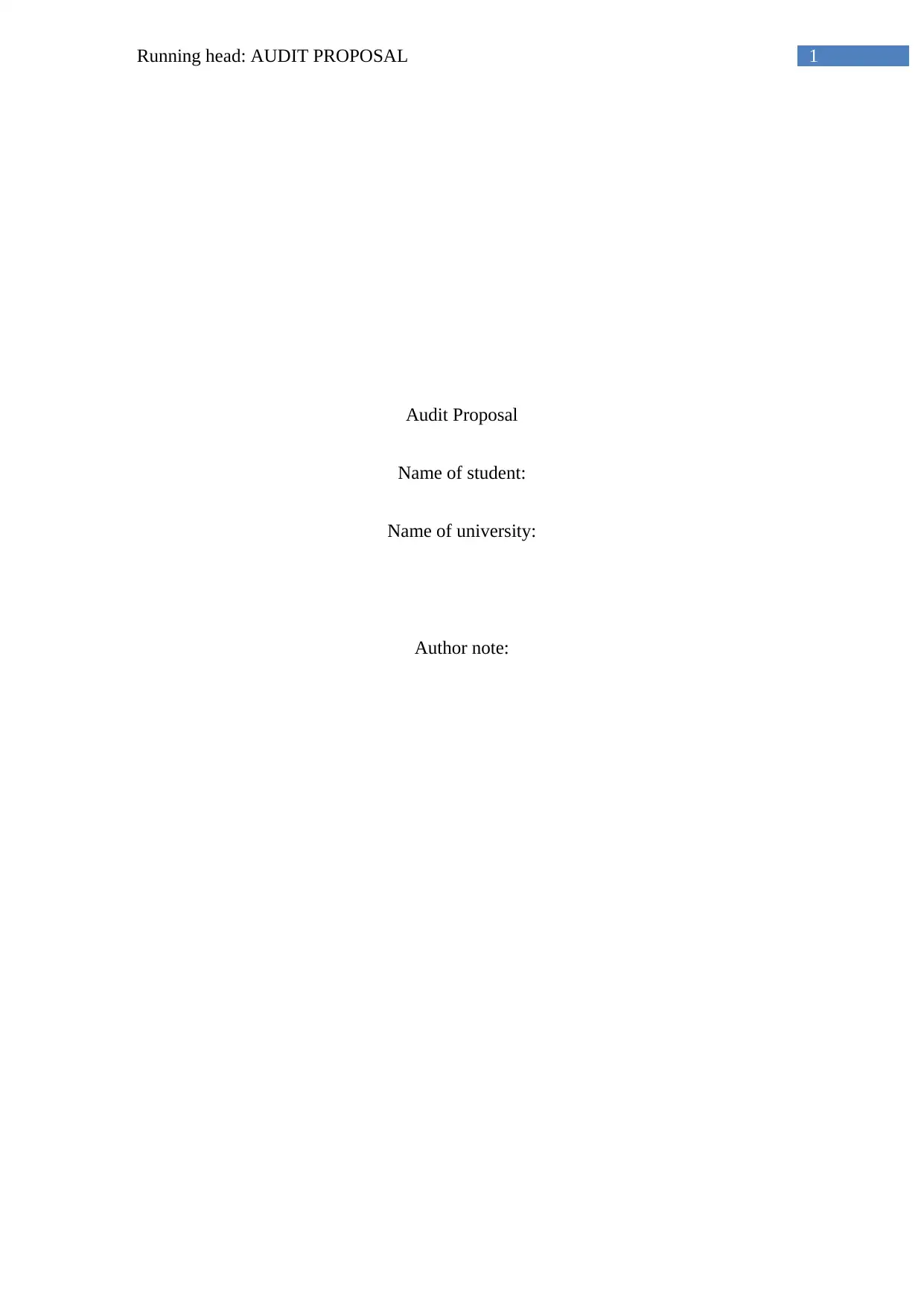
1Running head: AUDIT PROPOSAL
Audit Proposal
Name of student:
Name of university:
Author note:
Audit Proposal
Name of student:
Name of university:
Author note:
Paraphrase This Document
Need a fresh take? Get an instant paraphrase of this document with our AI Paraphraser
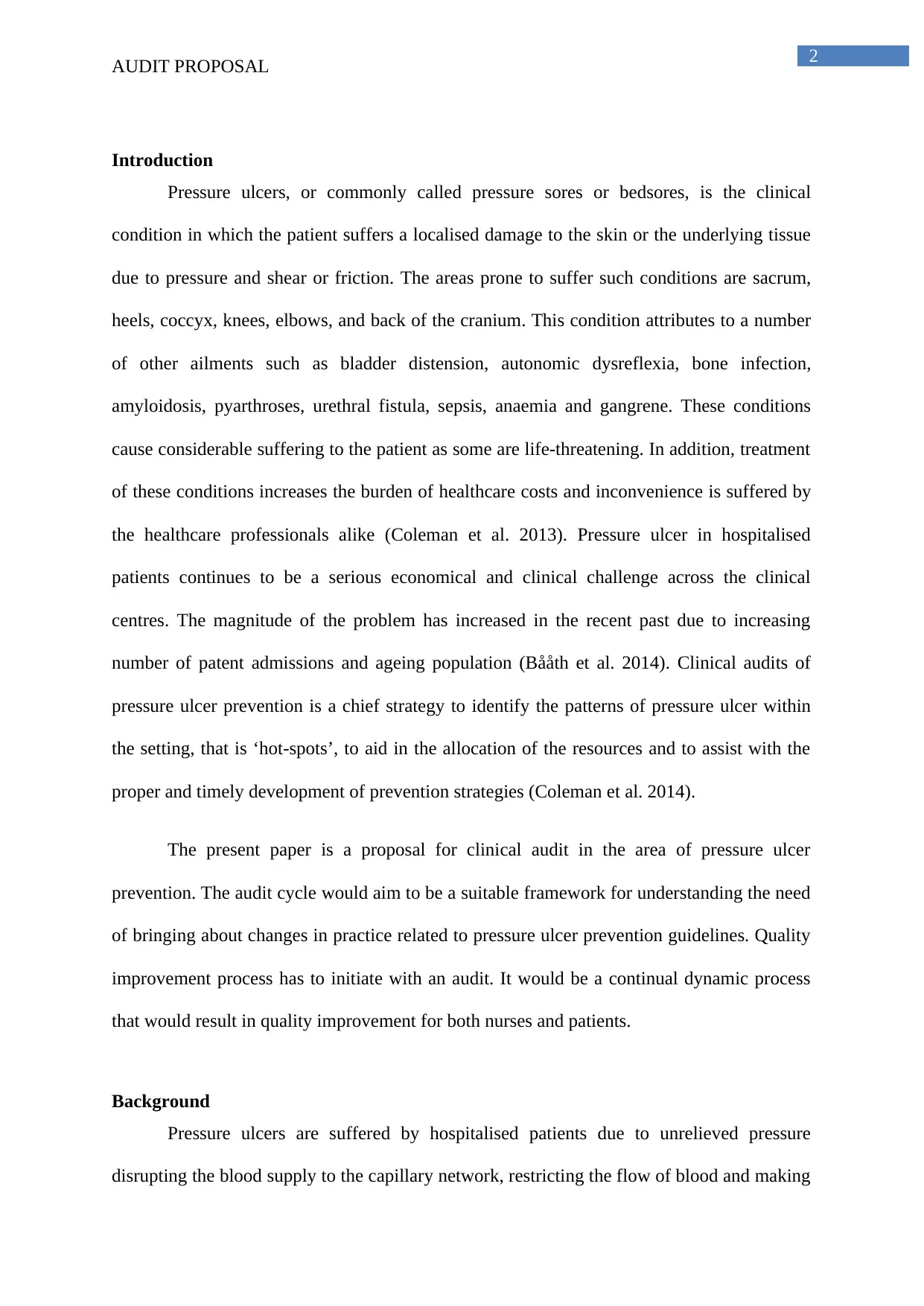
2
AUDIT PROPOSAL
Introduction
Pressure ulcers, or commonly called pressure sores or bedsores, is the clinical
condition in which the patient suffers a localised damage to the skin or the underlying tissue
due to pressure and shear or friction. The areas prone to suffer such conditions are sacrum,
heels, coccyx, knees, elbows, and back of the cranium. This condition attributes to a number
of other ailments such as bladder distension, autonomic dysreflexia, bone infection,
amyloidosis, pyarthroses, urethral fistula, sepsis, anaemia and gangrene. These conditions
cause considerable suffering to the patient as some are life-threatening. In addition, treatment
of these conditions increases the burden of healthcare costs and inconvenience is suffered by
the healthcare professionals alike (Coleman et al. 2013). Pressure ulcer in hospitalised
patients continues to be a serious economical and clinical challenge across the clinical
centres. The magnitude of the problem has increased in the recent past due to increasing
number of patent admissions and ageing population (Bååth et al. 2014). Clinical audits of
pressure ulcer prevention is a chief strategy to identify the patterns of pressure ulcer within
the setting, that is ‘hot-spots’, to aid in the allocation of the resources and to assist with the
proper and timely development of prevention strategies (Coleman et al. 2014).
The present paper is a proposal for clinical audit in the area of pressure ulcer
prevention. The audit cycle would aim to be a suitable framework for understanding the need
of bringing about changes in practice related to pressure ulcer prevention guidelines. Quality
improvement process has to initiate with an audit. It would be a continual dynamic process
that would result in quality improvement for both nurses and patients.
Background
Pressure ulcers are suffered by hospitalised patients due to unrelieved pressure
disrupting the blood supply to the capillary network, restricting the flow of blood and making
AUDIT PROPOSAL
Introduction
Pressure ulcers, or commonly called pressure sores or bedsores, is the clinical
condition in which the patient suffers a localised damage to the skin or the underlying tissue
due to pressure and shear or friction. The areas prone to suffer such conditions are sacrum,
heels, coccyx, knees, elbows, and back of the cranium. This condition attributes to a number
of other ailments such as bladder distension, autonomic dysreflexia, bone infection,
amyloidosis, pyarthroses, urethral fistula, sepsis, anaemia and gangrene. These conditions
cause considerable suffering to the patient as some are life-threatening. In addition, treatment
of these conditions increases the burden of healthcare costs and inconvenience is suffered by
the healthcare professionals alike (Coleman et al. 2013). Pressure ulcer in hospitalised
patients continues to be a serious economical and clinical challenge across the clinical
centres. The magnitude of the problem has increased in the recent past due to increasing
number of patent admissions and ageing population (Bååth et al. 2014). Clinical audits of
pressure ulcer prevention is a chief strategy to identify the patterns of pressure ulcer within
the setting, that is ‘hot-spots’, to aid in the allocation of the resources and to assist with the
proper and timely development of prevention strategies (Coleman et al. 2014).
The present paper is a proposal for clinical audit in the area of pressure ulcer
prevention. The audit cycle would aim to be a suitable framework for understanding the need
of bringing about changes in practice related to pressure ulcer prevention guidelines. Quality
improvement process has to initiate with an audit. It would be a continual dynamic process
that would result in quality improvement for both nurses and patients.
Background
Pressure ulcers are suffered by hospitalised patients due to unrelieved pressure
disrupting the blood supply to the capillary network, restricting the flow of blood and making
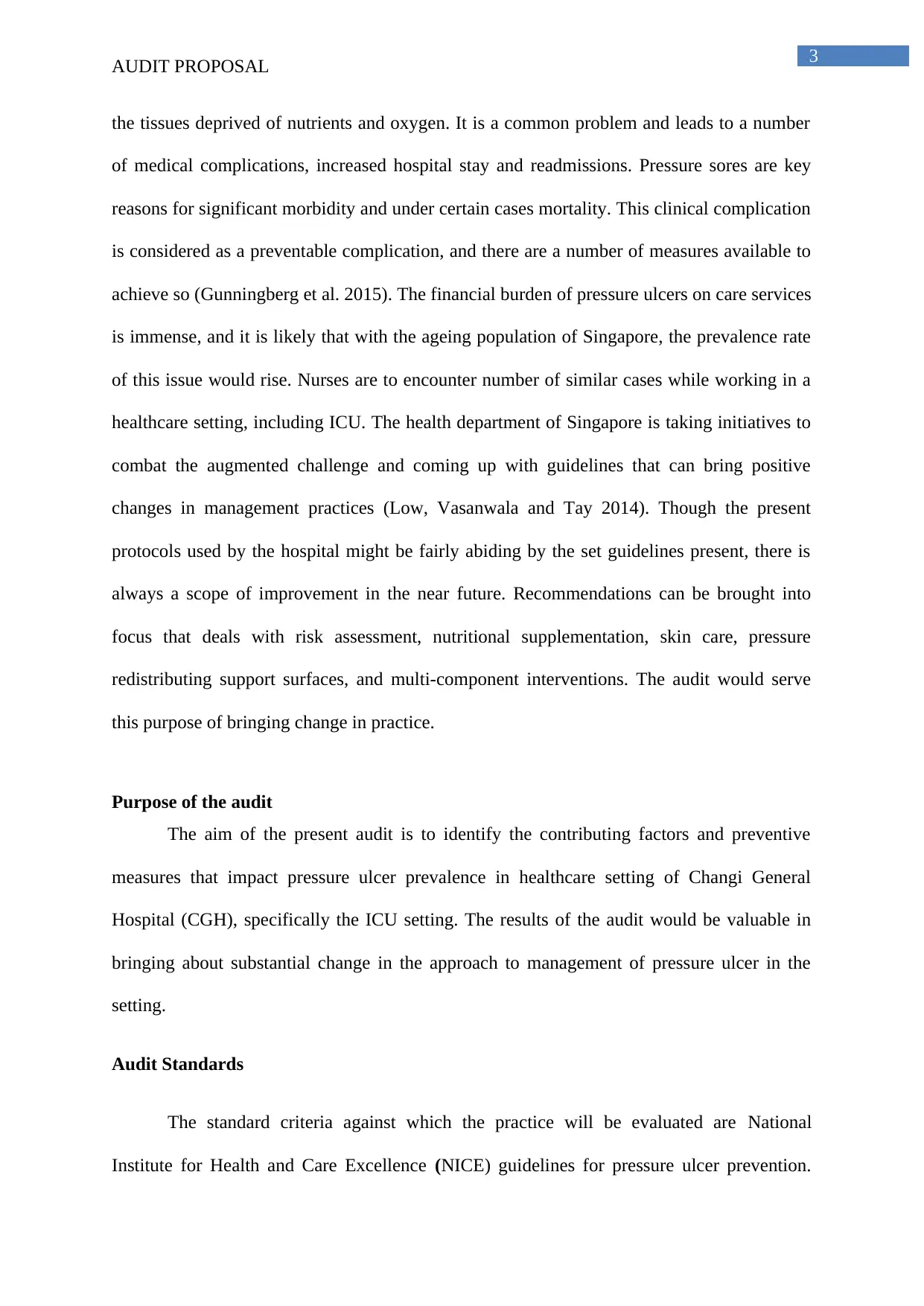
3
AUDIT PROPOSAL
the tissues deprived of nutrients and oxygen. It is a common problem and leads to a number
of medical complications, increased hospital stay and readmissions. Pressure sores are key
reasons for significant morbidity and under certain cases mortality. This clinical complication
is considered as a preventable complication, and there are a number of measures available to
achieve so (Gunningberg et al. 2015). The financial burden of pressure ulcers on care services
is immense, and it is likely that with the ageing population of Singapore, the prevalence rate
of this issue would rise. Nurses are to encounter number of similar cases while working in a
healthcare setting, including ICU. The health department of Singapore is taking initiatives to
combat the augmented challenge and coming up with guidelines that can bring positive
changes in management practices (Low, Vasanwala and Tay 2014). Though the present
protocols used by the hospital might be fairly abiding by the set guidelines present, there is
always a scope of improvement in the near future. Recommendations can be brought into
focus that deals with risk assessment, nutritional supplementation, skin care, pressure
redistributing support surfaces, and multi-component interventions. The audit would serve
this purpose of bringing change in practice.
Purpose of the audit
The aim of the present audit is to identify the contributing factors and preventive
measures that impact pressure ulcer prevalence in healthcare setting of Changi General
Hospital (CGH), specifically the ICU setting. The results of the audit would be valuable in
bringing about substantial change in the approach to management of pressure ulcer in the
setting.
Audit Standards
The standard criteria against which the practice will be evaluated are National
Institute for Health and Care Excellence (NICE) guidelines for pressure ulcer prevention.
AUDIT PROPOSAL
the tissues deprived of nutrients and oxygen. It is a common problem and leads to a number
of medical complications, increased hospital stay and readmissions. Pressure sores are key
reasons for significant morbidity and under certain cases mortality. This clinical complication
is considered as a preventable complication, and there are a number of measures available to
achieve so (Gunningberg et al. 2015). The financial burden of pressure ulcers on care services
is immense, and it is likely that with the ageing population of Singapore, the prevalence rate
of this issue would rise. Nurses are to encounter number of similar cases while working in a
healthcare setting, including ICU. The health department of Singapore is taking initiatives to
combat the augmented challenge and coming up with guidelines that can bring positive
changes in management practices (Low, Vasanwala and Tay 2014). Though the present
protocols used by the hospital might be fairly abiding by the set guidelines present, there is
always a scope of improvement in the near future. Recommendations can be brought into
focus that deals with risk assessment, nutritional supplementation, skin care, pressure
redistributing support surfaces, and multi-component interventions. The audit would serve
this purpose of bringing change in practice.
Purpose of the audit
The aim of the present audit is to identify the contributing factors and preventive
measures that impact pressure ulcer prevalence in healthcare setting of Changi General
Hospital (CGH), specifically the ICU setting. The results of the audit would be valuable in
bringing about substantial change in the approach to management of pressure ulcer in the
setting.
Audit Standards
The standard criteria against which the practice will be evaluated are National
Institute for Health and Care Excellence (NICE) guidelines for pressure ulcer prevention.
⊘ This is a preview!⊘
Do you want full access?
Subscribe today to unlock all pages.

Trusted by 1+ million students worldwide
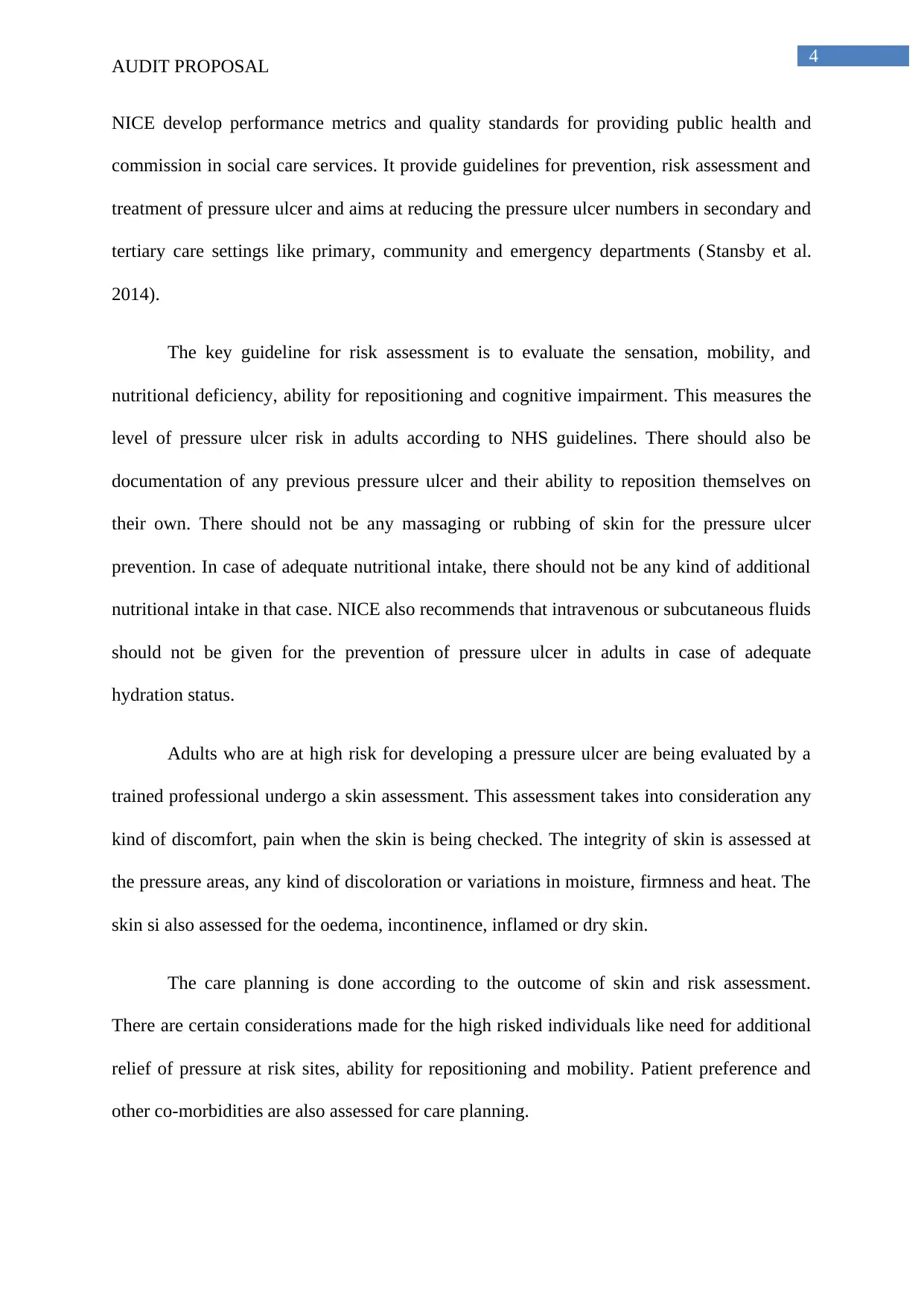
4
AUDIT PROPOSAL
NICE develop performance metrics and quality standards for providing public health and
commission in social care services. It provide guidelines for prevention, risk assessment and
treatment of pressure ulcer and aims at reducing the pressure ulcer numbers in secondary and
tertiary care settings like primary, community and emergency departments (Stansby et al.
2014).
The key guideline for risk assessment is to evaluate the sensation, mobility, and
nutritional deficiency, ability for repositioning and cognitive impairment. This measures the
level of pressure ulcer risk in adults according to NHS guidelines. There should also be
documentation of any previous pressure ulcer and their ability to reposition themselves on
their own. There should not be any massaging or rubbing of skin for the pressure ulcer
prevention. In case of adequate nutritional intake, there should not be any kind of additional
nutritional intake in that case. NICE also recommends that intravenous or subcutaneous fluids
should not be given for the prevention of pressure ulcer in adults in case of adequate
hydration status.
Adults who are at high risk for developing a pressure ulcer are being evaluated by a
trained professional undergo a skin assessment. This assessment takes into consideration any
kind of discomfort, pain when the skin is being checked. The integrity of skin is assessed at
the pressure areas, any kind of discoloration or variations in moisture, firmness and heat. The
skin si also assessed for the oedema, incontinence, inflamed or dry skin.
The care planning is done according to the outcome of skin and risk assessment.
There are certain considerations made for the high risked individuals like need for additional
relief of pressure at risk sites, ability for repositioning and mobility. Patient preference and
other co-morbidities are also assessed for care planning.
AUDIT PROPOSAL
NICE develop performance metrics and quality standards for providing public health and
commission in social care services. It provide guidelines for prevention, risk assessment and
treatment of pressure ulcer and aims at reducing the pressure ulcer numbers in secondary and
tertiary care settings like primary, community and emergency departments (Stansby et al.
2014).
The key guideline for risk assessment is to evaluate the sensation, mobility, and
nutritional deficiency, ability for repositioning and cognitive impairment. This measures the
level of pressure ulcer risk in adults according to NHS guidelines. There should also be
documentation of any previous pressure ulcer and their ability to reposition themselves on
their own. There should not be any massaging or rubbing of skin for the pressure ulcer
prevention. In case of adequate nutritional intake, there should not be any kind of additional
nutritional intake in that case. NICE also recommends that intravenous or subcutaneous fluids
should not be given for the prevention of pressure ulcer in adults in case of adequate
hydration status.
Adults who are at high risk for developing a pressure ulcer are being evaluated by a
trained professional undergo a skin assessment. This assessment takes into consideration any
kind of discomfort, pain when the skin is being checked. The integrity of skin is assessed at
the pressure areas, any kind of discoloration or variations in moisture, firmness and heat. The
skin si also assessed for the oedema, incontinence, inflamed or dry skin.
The care planning is done according to the outcome of skin and risk assessment.
There are certain considerations made for the high risked individuals like need for additional
relief of pressure at risk sites, ability for repositioning and mobility. Patient preference and
other co-morbidities are also assessed for care planning.
Paraphrase This Document
Need a fresh take? Get an instant paraphrase of this document with our AI Paraphraser
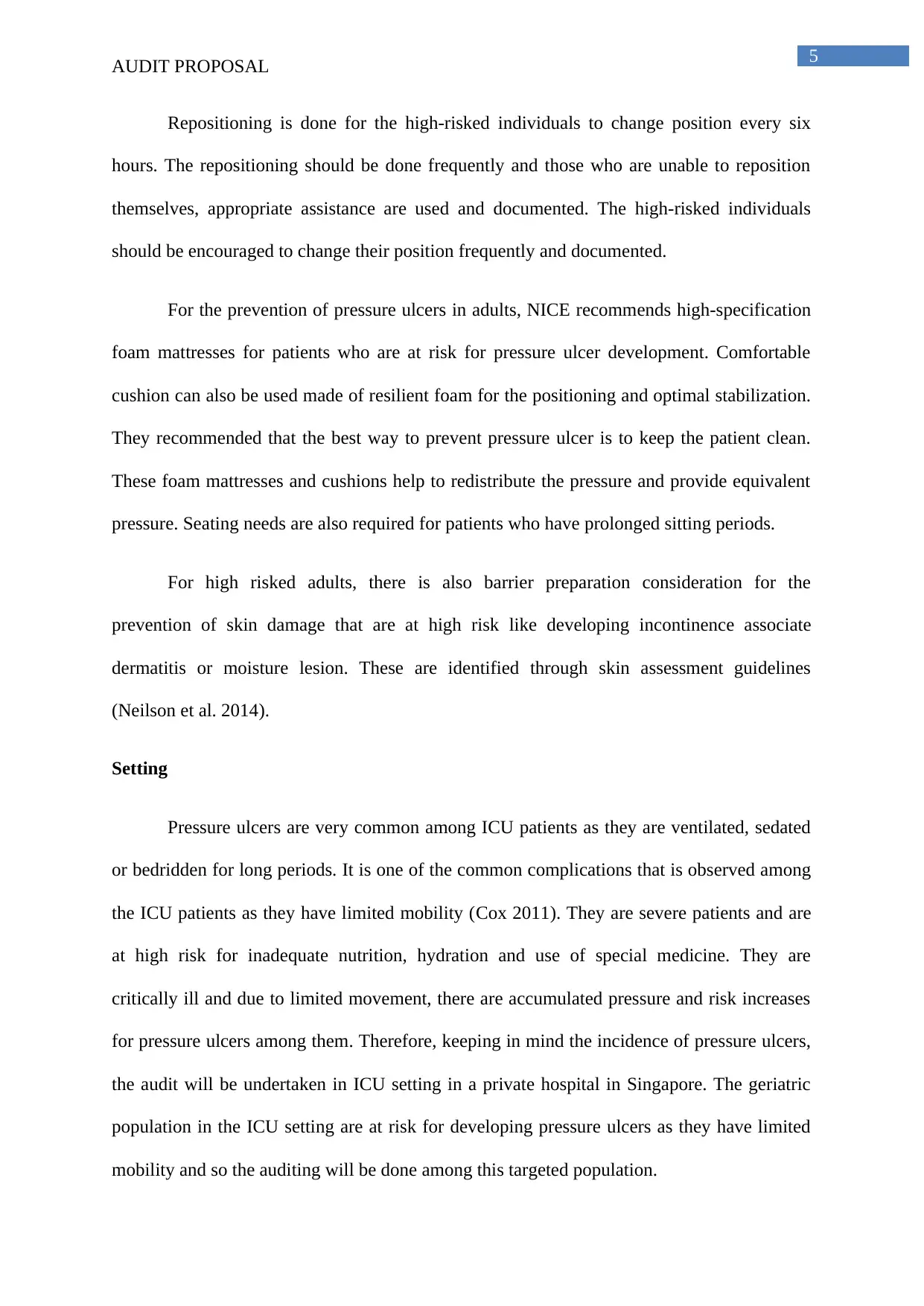
5
AUDIT PROPOSAL
Repositioning is done for the high-risked individuals to change position every six
hours. The repositioning should be done frequently and those who are unable to reposition
themselves, appropriate assistance are used and documented. The high-risked individuals
should be encouraged to change their position frequently and documented.
For the prevention of pressure ulcers in adults, NICE recommends high-specification
foam mattresses for patients who are at risk for pressure ulcer development. Comfortable
cushion can also be used made of resilient foam for the positioning and optimal stabilization.
They recommended that the best way to prevent pressure ulcer is to keep the patient clean.
These foam mattresses and cushions help to redistribute the pressure and provide equivalent
pressure. Seating needs are also required for patients who have prolonged sitting periods.
For high risked adults, there is also barrier preparation consideration for the
prevention of skin damage that are at high risk like developing incontinence associate
dermatitis or moisture lesion. These are identified through skin assessment guidelines
(Neilson et al. 2014).
Setting
Pressure ulcers are very common among ICU patients as they are ventilated, sedated
or bedridden for long periods. It is one of the common complications that is observed among
the ICU patients as they have limited mobility (Cox 2011). They are severe patients and are
at high risk for inadequate nutrition, hydration and use of special medicine. They are
critically ill and due to limited movement, there are accumulated pressure and risk increases
for pressure ulcers among them. Therefore, keeping in mind the incidence of pressure ulcers,
the audit will be undertaken in ICU setting in a private hospital in Singapore. The geriatric
population in the ICU setting are at risk for developing pressure ulcers as they have limited
mobility and so the auditing will be done among this targeted population.
AUDIT PROPOSAL
Repositioning is done for the high-risked individuals to change position every six
hours. The repositioning should be done frequently and those who are unable to reposition
themselves, appropriate assistance are used and documented. The high-risked individuals
should be encouraged to change their position frequently and documented.
For the prevention of pressure ulcers in adults, NICE recommends high-specification
foam mattresses for patients who are at risk for pressure ulcer development. Comfortable
cushion can also be used made of resilient foam for the positioning and optimal stabilization.
They recommended that the best way to prevent pressure ulcer is to keep the patient clean.
These foam mattresses and cushions help to redistribute the pressure and provide equivalent
pressure. Seating needs are also required for patients who have prolonged sitting periods.
For high risked adults, there is also barrier preparation consideration for the
prevention of skin damage that are at high risk like developing incontinence associate
dermatitis or moisture lesion. These are identified through skin assessment guidelines
(Neilson et al. 2014).
Setting
Pressure ulcers are very common among ICU patients as they are ventilated, sedated
or bedridden for long periods. It is one of the common complications that is observed among
the ICU patients as they have limited mobility (Cox 2011). They are severe patients and are
at high risk for inadequate nutrition, hydration and use of special medicine. They are
critically ill and due to limited movement, there are accumulated pressure and risk increases
for pressure ulcers among them. Therefore, keeping in mind the incidence of pressure ulcers,
the audit will be undertaken in ICU setting in a private hospital in Singapore. The geriatric
population in the ICU setting are at risk for developing pressure ulcers as they have limited
mobility and so the auditing will be done among this targeted population.
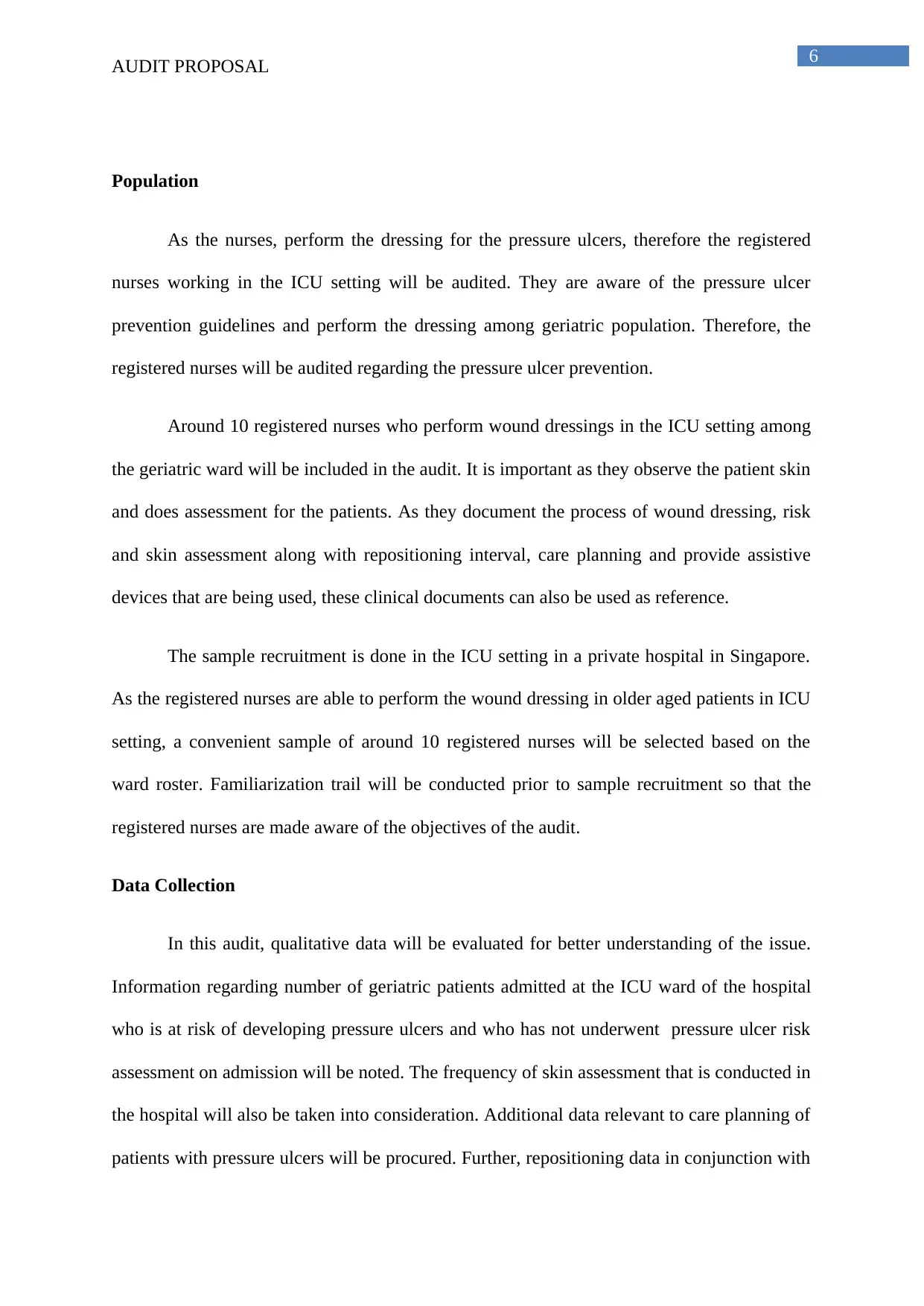
6
AUDIT PROPOSAL
Population
As the nurses, perform the dressing for the pressure ulcers, therefore the registered
nurses working in the ICU setting will be audited. They are aware of the pressure ulcer
prevention guidelines and perform the dressing among geriatric population. Therefore, the
registered nurses will be audited regarding the pressure ulcer prevention.
Around 10 registered nurses who perform wound dressings in the ICU setting among
the geriatric ward will be included in the audit. It is important as they observe the patient skin
and does assessment for the patients. As they document the process of wound dressing, risk
and skin assessment along with repositioning interval, care planning and provide assistive
devices that are being used, these clinical documents can also be used as reference.
The sample recruitment is done in the ICU setting in a private hospital in Singapore.
As the registered nurses are able to perform the wound dressing in older aged patients in ICU
setting, a convenient sample of around 10 registered nurses will be selected based on the
ward roster. Familiarization trail will be conducted prior to sample recruitment so that the
registered nurses are made aware of the objectives of the audit.
Data Collection
In this audit, qualitative data will be evaluated for better understanding of the issue.
Information regarding number of geriatric patients admitted at the ICU ward of the hospital
who is at risk of developing pressure ulcers and who has not underwent pressure ulcer risk
assessment on admission will be noted. The frequency of skin assessment that is conducted in
the hospital will also be taken into consideration. Additional data relevant to care planning of
patients with pressure ulcers will be procured. Further, repositioning data in conjunction with
AUDIT PROPOSAL
Population
As the nurses, perform the dressing for the pressure ulcers, therefore the registered
nurses working in the ICU setting will be audited. They are aware of the pressure ulcer
prevention guidelines and perform the dressing among geriatric population. Therefore, the
registered nurses will be audited regarding the pressure ulcer prevention.
Around 10 registered nurses who perform wound dressings in the ICU setting among
the geriatric ward will be included in the audit. It is important as they observe the patient skin
and does assessment for the patients. As they document the process of wound dressing, risk
and skin assessment along with repositioning interval, care planning and provide assistive
devices that are being used, these clinical documents can also be used as reference.
The sample recruitment is done in the ICU setting in a private hospital in Singapore.
As the registered nurses are able to perform the wound dressing in older aged patients in ICU
setting, a convenient sample of around 10 registered nurses will be selected based on the
ward roster. Familiarization trail will be conducted prior to sample recruitment so that the
registered nurses are made aware of the objectives of the audit.
Data Collection
In this audit, qualitative data will be evaluated for better understanding of the issue.
Information regarding number of geriatric patients admitted at the ICU ward of the hospital
who is at risk of developing pressure ulcers and who has not underwent pressure ulcer risk
assessment on admission will be noted. The frequency of skin assessment that is conducted in
the hospital will also be taken into consideration. Additional data relevant to care planning of
patients with pressure ulcers will be procured. Further, repositioning data in conjunction with
⊘ This is a preview!⊘
Do you want full access?
Subscribe today to unlock all pages.

Trusted by 1+ million students worldwide
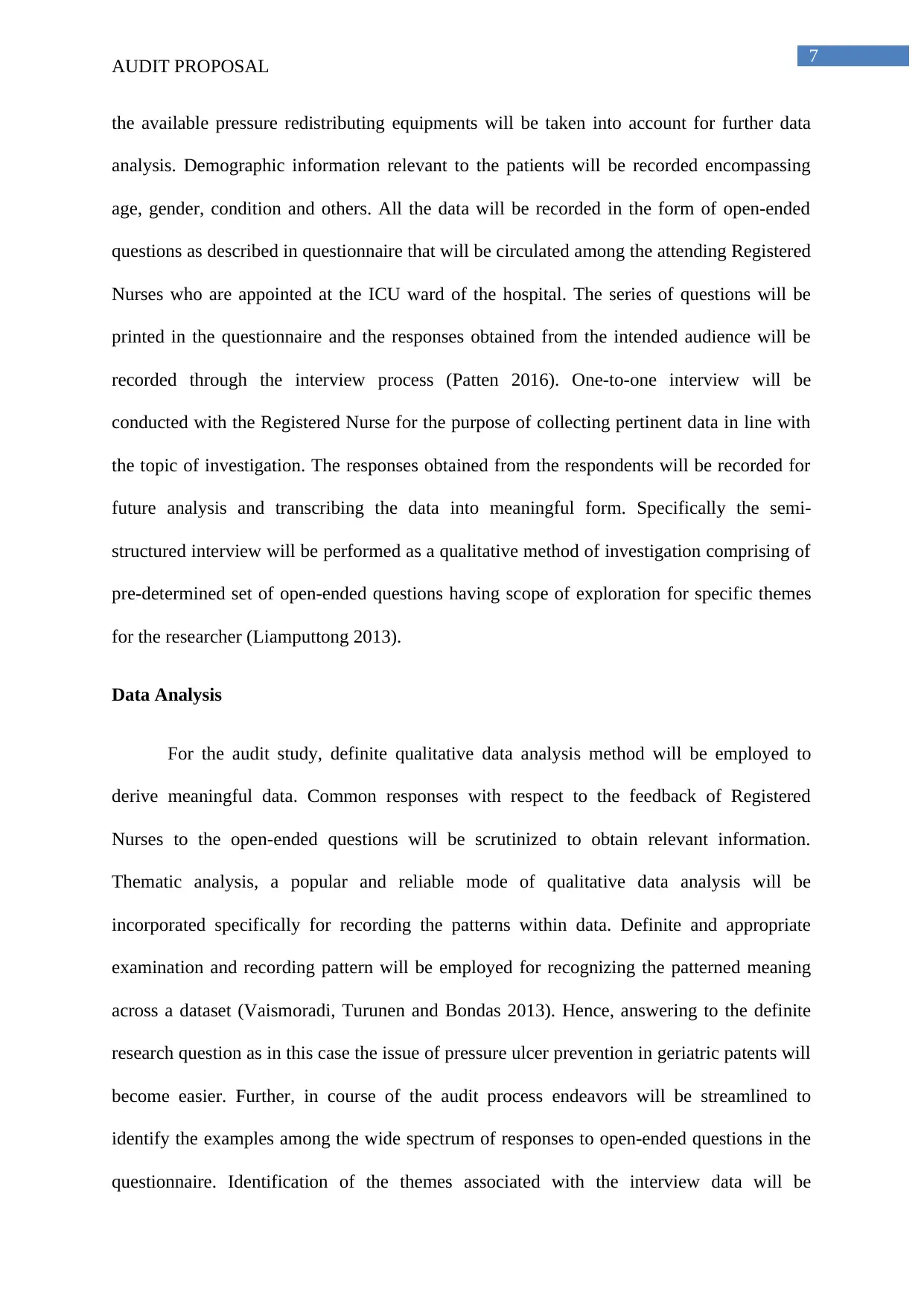
7
AUDIT PROPOSAL
the available pressure redistributing equipments will be taken into account for further data
analysis. Demographic information relevant to the patients will be recorded encompassing
age, gender, condition and others. All the data will be recorded in the form of open-ended
questions as described in questionnaire that will be circulated among the attending Registered
Nurses who are appointed at the ICU ward of the hospital. The series of questions will be
printed in the questionnaire and the responses obtained from the intended audience will be
recorded through the interview process (Patten 2016). One-to-one interview will be
conducted with the Registered Nurse for the purpose of collecting pertinent data in line with
the topic of investigation. The responses obtained from the respondents will be recorded for
future analysis and transcribing the data into meaningful form. Specifically the semi-
structured interview will be performed as a qualitative method of investigation comprising of
pre-determined set of open-ended questions having scope of exploration for specific themes
for the researcher (Liamputtong 2013).
Data Analysis
For the audit study, definite qualitative data analysis method will be employed to
derive meaningful data. Common responses with respect to the feedback of Registered
Nurses to the open-ended questions will be scrutinized to obtain relevant information.
Thematic analysis, a popular and reliable mode of qualitative data analysis will be
incorporated specifically for recording the patterns within data. Definite and appropriate
examination and recording pattern will be employed for recognizing the patterned meaning
across a dataset (Vaismoradi, Turunen and Bondas 2013). Hence, answering to the definite
research question as in this case the issue of pressure ulcer prevention in geriatric patents will
become easier. Further, in course of the audit process endeavors will be streamlined to
identify the examples among the wide spectrum of responses to open-ended questions in the
questionnaire. Identification of the themes associated with the interview data will be
AUDIT PROPOSAL
the available pressure redistributing equipments will be taken into account for further data
analysis. Demographic information relevant to the patients will be recorded encompassing
age, gender, condition and others. All the data will be recorded in the form of open-ended
questions as described in questionnaire that will be circulated among the attending Registered
Nurses who are appointed at the ICU ward of the hospital. The series of questions will be
printed in the questionnaire and the responses obtained from the intended audience will be
recorded through the interview process (Patten 2016). One-to-one interview will be
conducted with the Registered Nurse for the purpose of collecting pertinent data in line with
the topic of investigation. The responses obtained from the respondents will be recorded for
future analysis and transcribing the data into meaningful form. Specifically the semi-
structured interview will be performed as a qualitative method of investigation comprising of
pre-determined set of open-ended questions having scope of exploration for specific themes
for the researcher (Liamputtong 2013).
Data Analysis
For the audit study, definite qualitative data analysis method will be employed to
derive meaningful data. Common responses with respect to the feedback of Registered
Nurses to the open-ended questions will be scrutinized to obtain relevant information.
Thematic analysis, a popular and reliable mode of qualitative data analysis will be
incorporated specifically for recording the patterns within data. Definite and appropriate
examination and recording pattern will be employed for recognizing the patterned meaning
across a dataset (Vaismoradi, Turunen and Bondas 2013). Hence, answering to the definite
research question as in this case the issue of pressure ulcer prevention in geriatric patents will
become easier. Further, in course of the audit process endeavors will be streamlined to
identify the examples among the wide spectrum of responses to open-ended questions in the
questionnaire. Identification of the themes associated with the interview data will be
Paraphrase This Document
Need a fresh take? Get an instant paraphrase of this document with our AI Paraphraser
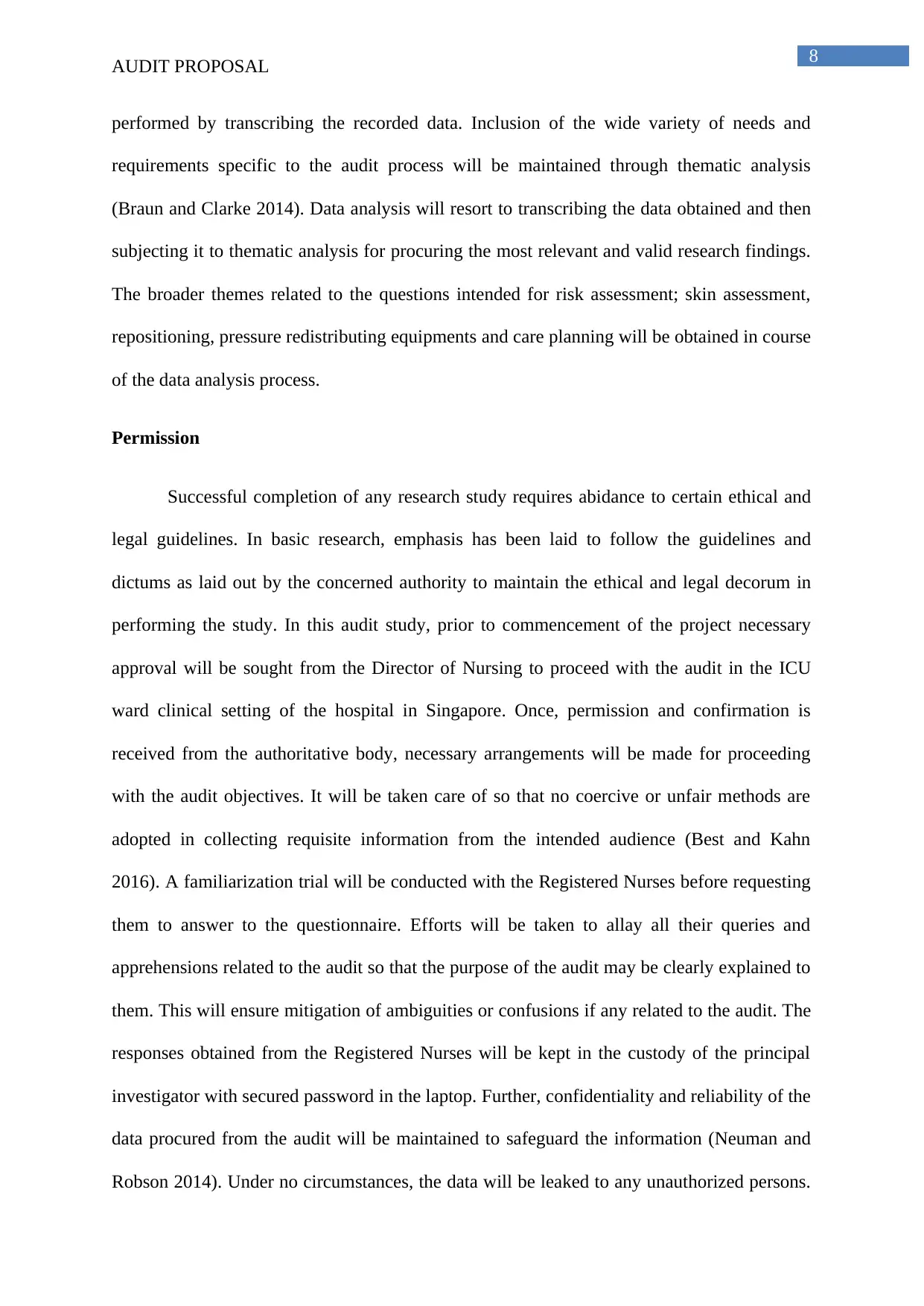
8
AUDIT PROPOSAL
performed by transcribing the recorded data. Inclusion of the wide variety of needs and
requirements specific to the audit process will be maintained through thematic analysis
(Braun and Clarke 2014). Data analysis will resort to transcribing the data obtained and then
subjecting it to thematic analysis for procuring the most relevant and valid research findings.
The broader themes related to the questions intended for risk assessment; skin assessment,
repositioning, pressure redistributing equipments and care planning will be obtained in course
of the data analysis process.
Permission
Successful completion of any research study requires abidance to certain ethical and
legal guidelines. In basic research, emphasis has been laid to follow the guidelines and
dictums as laid out by the concerned authority to maintain the ethical and legal decorum in
performing the study. In this audit study, prior to commencement of the project necessary
approval will be sought from the Director of Nursing to proceed with the audit in the ICU
ward clinical setting of the hospital in Singapore. Once, permission and confirmation is
received from the authoritative body, necessary arrangements will be made for proceeding
with the audit objectives. It will be taken care of so that no coercive or unfair methods are
adopted in collecting requisite information from the intended audience (Best and Kahn
2016). A familiarization trial will be conducted with the Registered Nurses before requesting
them to answer to the questionnaire. Efforts will be taken to allay all their queries and
apprehensions related to the audit so that the purpose of the audit may be clearly explained to
them. This will ensure mitigation of ambiguities or confusions if any related to the audit. The
responses obtained from the Registered Nurses will be kept in the custody of the principal
investigator with secured password in the laptop. Further, confidentiality and reliability of the
data procured from the audit will be maintained to safeguard the information (Neuman and
Robson 2014). Under no circumstances, the data will be leaked to any unauthorized persons.
AUDIT PROPOSAL
performed by transcribing the recorded data. Inclusion of the wide variety of needs and
requirements specific to the audit process will be maintained through thematic analysis
(Braun and Clarke 2014). Data analysis will resort to transcribing the data obtained and then
subjecting it to thematic analysis for procuring the most relevant and valid research findings.
The broader themes related to the questions intended for risk assessment; skin assessment,
repositioning, pressure redistributing equipments and care planning will be obtained in course
of the data analysis process.
Permission
Successful completion of any research study requires abidance to certain ethical and
legal guidelines. In basic research, emphasis has been laid to follow the guidelines and
dictums as laid out by the concerned authority to maintain the ethical and legal decorum in
performing the study. In this audit study, prior to commencement of the project necessary
approval will be sought from the Director of Nursing to proceed with the audit in the ICU
ward clinical setting of the hospital in Singapore. Once, permission and confirmation is
received from the authoritative body, necessary arrangements will be made for proceeding
with the audit objectives. It will be taken care of so that no coercive or unfair methods are
adopted in collecting requisite information from the intended audience (Best and Kahn
2016). A familiarization trial will be conducted with the Registered Nurses before requesting
them to answer to the questionnaire. Efforts will be taken to allay all their queries and
apprehensions related to the audit so that the purpose of the audit may be clearly explained to
them. This will ensure mitigation of ambiguities or confusions if any related to the audit. The
responses obtained from the Registered Nurses will be kept in the custody of the principal
investigator with secured password in the laptop. Further, confidentiality and reliability of the
data procured from the audit will be maintained to safeguard the information (Neuman and
Robson 2014). Under no circumstances, the data will be leaked to any unauthorized persons.
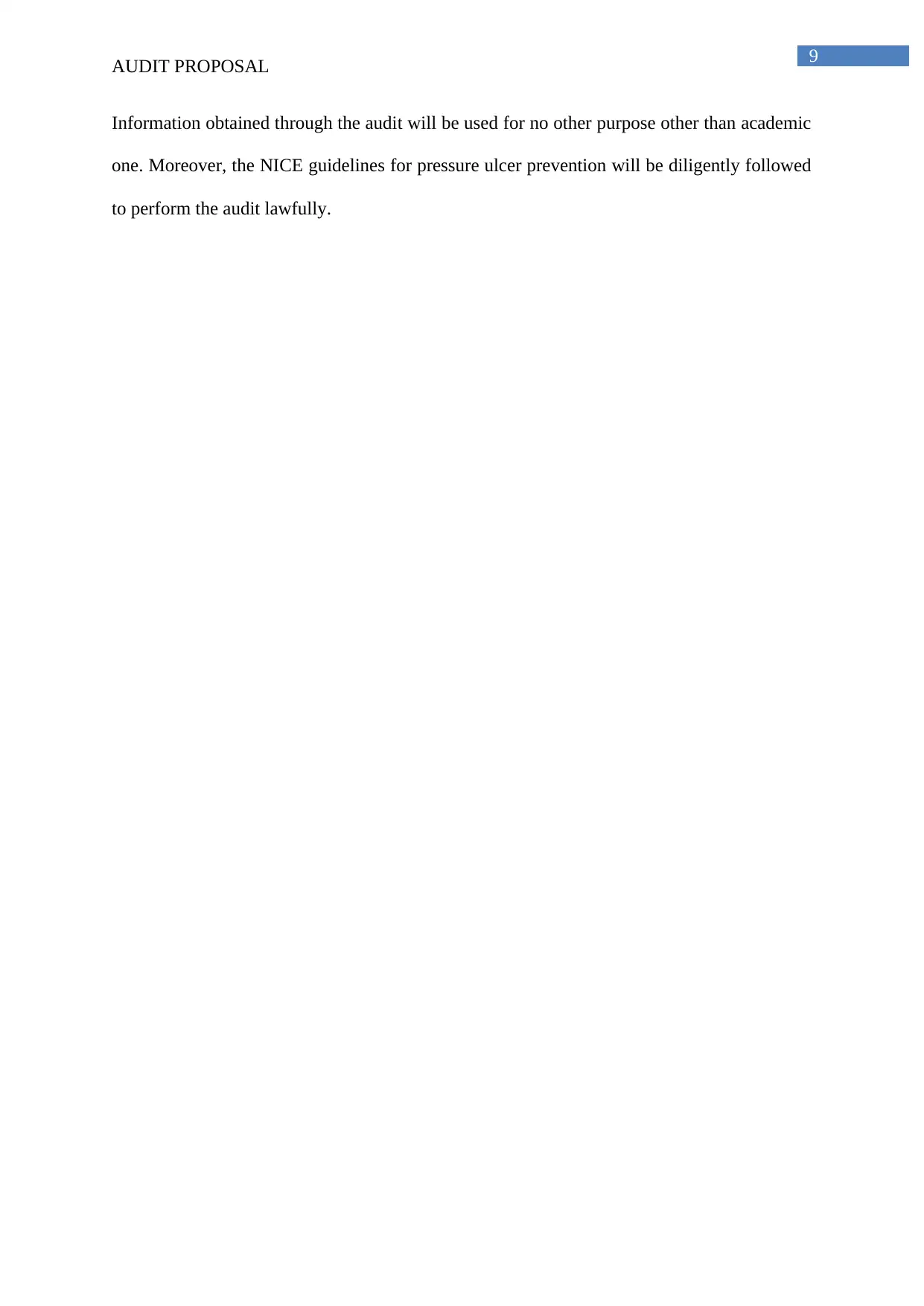
9
AUDIT PROPOSAL
Information obtained through the audit will be used for no other purpose other than academic
one. Moreover, the NICE guidelines for pressure ulcer prevention will be diligently followed
to perform the audit lawfully.
AUDIT PROPOSAL
Information obtained through the audit will be used for no other purpose other than academic
one. Moreover, the NICE guidelines for pressure ulcer prevention will be diligently followed
to perform the audit lawfully.
⊘ This is a preview!⊘
Do you want full access?
Subscribe today to unlock all pages.

Trusted by 1+ million students worldwide
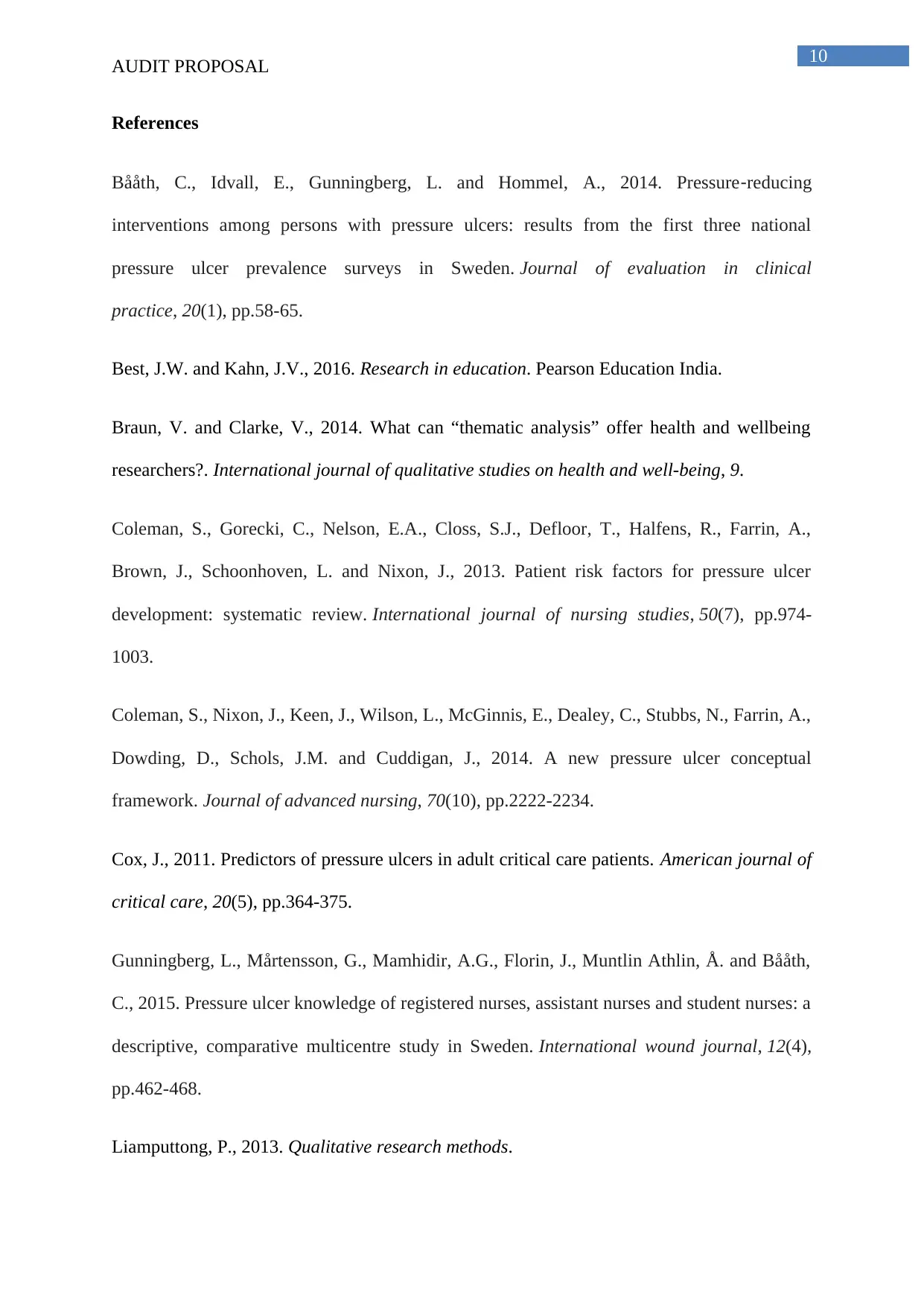
10
AUDIT PROPOSAL
References
Bååth, C., Idvall, E., Gunningberg, L. and Hommel, A., 2014. Pressure‐reducing
interventions among persons with pressure ulcers: results from the first three national
pressure ulcer prevalence surveys in Sweden. Journal of evaluation in clinical
practice, 20(1), pp.58-65.
Best, J.W. and Kahn, J.V., 2016. Research in education. Pearson Education India.
Braun, V. and Clarke, V., 2014. What can “thematic analysis” offer health and wellbeing
researchers?. International journal of qualitative studies on health and well-being, 9.
Coleman, S., Gorecki, C., Nelson, E.A., Closs, S.J., Defloor, T., Halfens, R., Farrin, A.,
Brown, J., Schoonhoven, L. and Nixon, J., 2013. Patient risk factors for pressure ulcer
development: systematic review. International journal of nursing studies, 50(7), pp.974-
1003.
Coleman, S., Nixon, J., Keen, J., Wilson, L., McGinnis, E., Dealey, C., Stubbs, N., Farrin, A.,
Dowding, D., Schols, J.M. and Cuddigan, J., 2014. A new pressure ulcer conceptual
framework. Journal of advanced nursing, 70(10), pp.2222-2234.
Cox, J., 2011. Predictors of pressure ulcers in adult critical care patients. American journal of
critical care, 20(5), pp.364-375.
Gunningberg, L., Mårtensson, G., Mamhidir, A.G., Florin, J., Muntlin Athlin, Å. and Bååth,
C., 2015. Pressure ulcer knowledge of registered nurses, assistant nurses and student nurses: a
descriptive, comparative multicentre study in Sweden. International wound journal, 12(4),
pp.462-468.
Liamputtong, P., 2013. Qualitative research methods.
AUDIT PROPOSAL
References
Bååth, C., Idvall, E., Gunningberg, L. and Hommel, A., 2014. Pressure‐reducing
interventions among persons with pressure ulcers: results from the first three national
pressure ulcer prevalence surveys in Sweden. Journal of evaluation in clinical
practice, 20(1), pp.58-65.
Best, J.W. and Kahn, J.V., 2016. Research in education. Pearson Education India.
Braun, V. and Clarke, V., 2014. What can “thematic analysis” offer health and wellbeing
researchers?. International journal of qualitative studies on health and well-being, 9.
Coleman, S., Gorecki, C., Nelson, E.A., Closs, S.J., Defloor, T., Halfens, R., Farrin, A.,
Brown, J., Schoonhoven, L. and Nixon, J., 2013. Patient risk factors for pressure ulcer
development: systematic review. International journal of nursing studies, 50(7), pp.974-
1003.
Coleman, S., Nixon, J., Keen, J., Wilson, L., McGinnis, E., Dealey, C., Stubbs, N., Farrin, A.,
Dowding, D., Schols, J.M. and Cuddigan, J., 2014. A new pressure ulcer conceptual
framework. Journal of advanced nursing, 70(10), pp.2222-2234.
Cox, J., 2011. Predictors of pressure ulcers in adult critical care patients. American journal of
critical care, 20(5), pp.364-375.
Gunningberg, L., Mårtensson, G., Mamhidir, A.G., Florin, J., Muntlin Athlin, Å. and Bååth,
C., 2015. Pressure ulcer knowledge of registered nurses, assistant nurses and student nurses: a
descriptive, comparative multicentre study in Sweden. International wound journal, 12(4),
pp.462-468.
Liamputtong, P., 2013. Qualitative research methods.
Paraphrase This Document
Need a fresh take? Get an instant paraphrase of this document with our AI Paraphraser
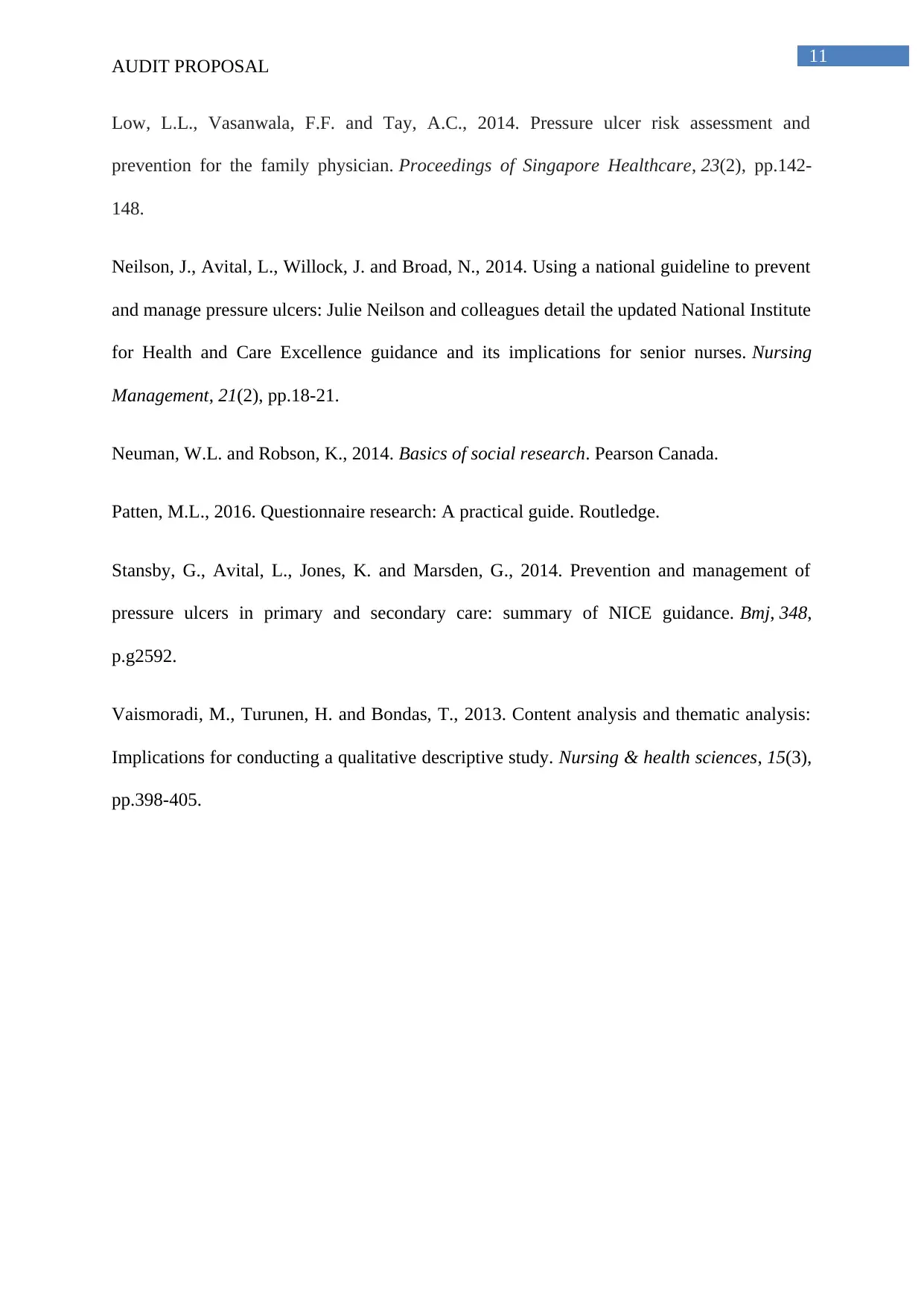
11
AUDIT PROPOSAL
Low, L.L., Vasanwala, F.F. and Tay, A.C., 2014. Pressure ulcer risk assessment and
prevention for the family physician. Proceedings of Singapore Healthcare, 23(2), pp.142-
148.
Neilson, J., Avital, L., Willock, J. and Broad, N., 2014. Using a national guideline to prevent
and manage pressure ulcers: Julie Neilson and colleagues detail the updated National Institute
for Health and Care Excellence guidance and its implications for senior nurses. Nursing
Management, 21(2), pp.18-21.
Neuman, W.L. and Robson, K., 2014. Basics of social research. Pearson Canada.
Patten, M.L., 2016. Questionnaire research: A practical guide. Routledge.
Stansby, G., Avital, L., Jones, K. and Marsden, G., 2014. Prevention and management of
pressure ulcers in primary and secondary care: summary of NICE guidance. Bmj, 348,
p.g2592.
Vaismoradi, M., Turunen, H. and Bondas, T., 2013. Content analysis and thematic analysis:
Implications for conducting a qualitative descriptive study. Nursing & health sciences, 15(3),
pp.398-405.
AUDIT PROPOSAL
Low, L.L., Vasanwala, F.F. and Tay, A.C., 2014. Pressure ulcer risk assessment and
prevention for the family physician. Proceedings of Singapore Healthcare, 23(2), pp.142-
148.
Neilson, J., Avital, L., Willock, J. and Broad, N., 2014. Using a national guideline to prevent
and manage pressure ulcers: Julie Neilson and colleagues detail the updated National Institute
for Health and Care Excellence guidance and its implications for senior nurses. Nursing
Management, 21(2), pp.18-21.
Neuman, W.L. and Robson, K., 2014. Basics of social research. Pearson Canada.
Patten, M.L., 2016. Questionnaire research: A practical guide. Routledge.
Stansby, G., Avital, L., Jones, K. and Marsden, G., 2014. Prevention and management of
pressure ulcers in primary and secondary care: summary of NICE guidance. Bmj, 348,
p.g2592.
Vaismoradi, M., Turunen, H. and Bondas, T., 2013. Content analysis and thematic analysis:
Implications for conducting a qualitative descriptive study. Nursing & health sciences, 15(3),
pp.398-405.
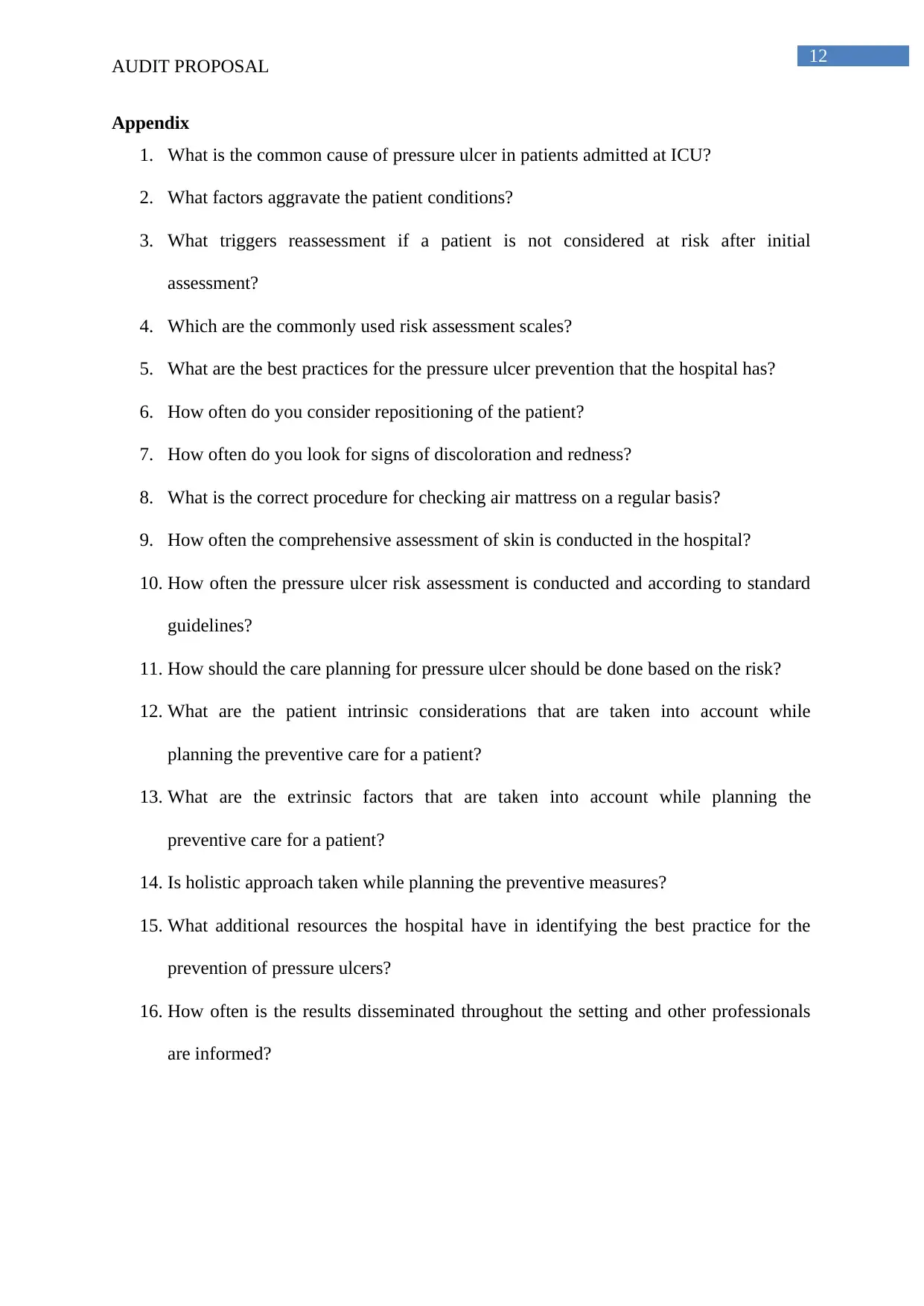
12
AUDIT PROPOSAL
Appendix
1. What is the common cause of pressure ulcer in patients admitted at ICU?
2. What factors aggravate the patient conditions?
3. What triggers reassessment if a patient is not considered at risk after initial
assessment?
4. Which are the commonly used risk assessment scales?
5. What are the best practices for the pressure ulcer prevention that the hospital has?
6. How often do you consider repositioning of the patient?
7. How often do you look for signs of discoloration and redness?
8. What is the correct procedure for checking air mattress on a regular basis?
9. How often the comprehensive assessment of skin is conducted in the hospital?
10. How often the pressure ulcer risk assessment is conducted and according to standard
guidelines?
11. How should the care planning for pressure ulcer should be done based on the risk?
12. What are the patient intrinsic considerations that are taken into account while
planning the preventive care for a patient?
13. What are the extrinsic factors that are taken into account while planning the
preventive care for a patient?
14. Is holistic approach taken while planning the preventive measures?
15. What additional resources the hospital have in identifying the best practice for the
prevention of pressure ulcers?
16. How often is the results disseminated throughout the setting and other professionals
are informed?
AUDIT PROPOSAL
Appendix
1. What is the common cause of pressure ulcer in patients admitted at ICU?
2. What factors aggravate the patient conditions?
3. What triggers reassessment if a patient is not considered at risk after initial
assessment?
4. Which are the commonly used risk assessment scales?
5. What are the best practices for the pressure ulcer prevention that the hospital has?
6. How often do you consider repositioning of the patient?
7. How often do you look for signs of discoloration and redness?
8. What is the correct procedure for checking air mattress on a regular basis?
9. How often the comprehensive assessment of skin is conducted in the hospital?
10. How often the pressure ulcer risk assessment is conducted and according to standard
guidelines?
11. How should the care planning for pressure ulcer should be done based on the risk?
12. What are the patient intrinsic considerations that are taken into account while
planning the preventive care for a patient?
13. What are the extrinsic factors that are taken into account while planning the
preventive care for a patient?
14. Is holistic approach taken while planning the preventive measures?
15. What additional resources the hospital have in identifying the best practice for the
prevention of pressure ulcers?
16. How often is the results disseminated throughout the setting and other professionals
are informed?
⊘ This is a preview!⊘
Do you want full access?
Subscribe today to unlock all pages.

Trusted by 1+ million students worldwide
1 out of 12
Related Documents
Your All-in-One AI-Powered Toolkit for Academic Success.
+13062052269
info@desklib.com
Available 24*7 on WhatsApp / Email
![[object Object]](/_next/static/media/star-bottom.7253800d.svg)
Unlock your academic potential
Copyright © 2020–2025 A2Z Services. All Rights Reserved. Developed and managed by ZUCOL.




